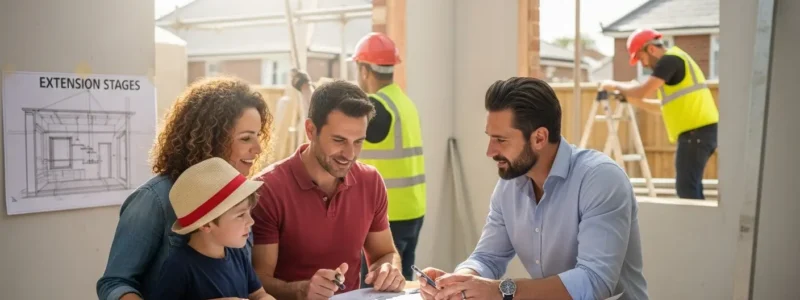Thinking about a home extension in London might sound like a dream solution for cramped living. Yet despite thousands of property owners investing in extensions across the capital each year, nearly 40 percent end up with spaces that fall short of their expectations. Most people assume the challenge comes down to planning permission or construction, but that’s not the whole story. The real key is knowing precisely what you want from your new space before anything else, and this starting point changes everything.
Table of Contents
- 1: Define Your Purpose And Space Requirements
- 2: Understand Local Planning Regulations
- 3: Choose The Right Design Style For Your Home
- 4: Maximise Natural Light In Your Extension
- 5: Incorporate Open-Plan Living Concepts
- 6: Consider Energy Efficiency And Sustainability
- 7: Plan For Future Needs And Flexibility
Quick Summary
| Takeaway | Explanation |
|---|---|
| Define your purpose clearly | Know why you need an extension to guide your design and decision-making processes. |
| Understand local planning regulations | Familiarise yourself with permissions and restrictions to avoid legal issues during construction. |
| Maximise natural light | Incorporate large windows and skylights to enhance the vibrancy of your new space. |
| Consider open-plan living | Design interconnected spaces to enhance flexibility and social interaction in your home. |
| Plan for future adaptability | Design versatile spaces that can evolve with changing family needs and lifestyles. |
1: Define Your Purpose and Space Requirements
When planning a home extension in London, the first critical step involves clearly defining your purpose and space requirements. Understanding precisely why you want to extend your home will guide every subsequent design decision and ensure your investment meets your family’s specific needs.
London properties often present unique spatial challenges, making strategic planning essential. Your extension might serve multiple potential purposes, such as creating additional living space, expanding a kitchen, adding a home office, or generating a multipurpose room that adapts to changing family dynamics.
Key considerations when defining your space requirements include:
Functionality: Determine how the new space will be used daily
Future-proofing: Consider potential long-term family needs and lifestyle changes
Property value: Assess how the extension might impact your home’s market potential
Careful measurement and spatial analysis are fundamental. Our step by step double-storey extension guide can provide additional insights into maximising your available space. Before committing to a specific design, conduct a thorough assessment of your current property layout.
According to Royal Institute of British Architects, successful home extensions require meticulous planning and a clear understanding of both architectural constraints and personal requirements. This means examining not just square metres, but how those spaces will genuinely enhance your living experience.
Consider consulting a professional who can help translate your vision into a practical, buildable design that respects London’s complex planning regulations and your property’s structural limitations. Your extension should not only meet immediate needs but also create a harmonious addition to your existing home.
2: Understand Local Planning Regulations
Navigating London’s complex planning regulations is crucial for any home extension project. Each borough has specific rules governing construction modifications, and understanding these requirements prevents potential legal complications and costly redesigns.
Understanding planning permissions can be intricate, with variations depending on your property type, location, and proposed extension scale. Our comprehensive guide on planning permission requirements offers detailed insights into this process.
Key regulatory considerations include:
Permitted Development Rights: Determine what modifications you can make without formal planning permission
Conservation Area Restrictions: Special rules for properties in historically significant neighbourhoods
Building Regulation Compliance: Ensuring structural integrity and safety standards
According to the UK Government’s Planning Portal, most home extensions require careful assessment. Some projects might fall under Permitted Development, which allows certain improvements without full planning application. However, these rights come with specific limitations regarding:
Maximum height restrictions
Proximity to property boundaries
Total floor area coverage
London boroughs have nuanced interpretations of these regulations. What might be acceptable in Wandsworth could be restricted in Kensington and Chelsea. Professional guidance becomes invaluable in interpreting these complex local guidelines.
Before proceeding, consult your local planning department. Detailed pre-application discussions can save significant time and prevent potential rejection of your extension plans. Engaging an experienced architectural professional who understands local regulatory landscapes will help you navigate these intricate requirements effectively.
3: Choose the Right Design Style for Your Home
Selecting the right design style for your home extension requires careful consideration of your property’s architectural heritage, personal aesthetic preferences, and contemporary design principles. London’s diverse architectural landscape offers numerous opportunities for creating a harmonious and visually compelling extension.
Explore our modern extension design ideas to inspire your project and understand how different styles can transform your living space.
Key design style considerations include:
Architectural Harmony: Ensure the extension complements your existing home’s character
Material Continuity: Select materials that blend seamlessly with your current structure
Contemporary vs Traditional: Choose an approach that reflects your personal taste and neighbourhood context
According to the Royal Institute of British Architects, successful home extensions should create a dialogue between old and new architectural elements. This means your extension can be either a subtle sympathetic addition or a bold contemporary statement.
Modern London homes often benefit from design styles that incorporate:
Clean, minimalist lines
Large glass surfaces for natural light
Open plan configurations
Consider your property’s original architectural period. Victorian and Edwardian homes might require a more sensitive approach, while mid-century properties could accommodate more radical design interventions. The goal is creating a space that feels like a natural progression of your home’s existing character.
Professional architects can help translate your vision into a cohesive design that respects both your personal style and the broader architectural context of your neighbourhood. Remember that a well-executed extension not only enhances your living experience but can significantly improve your property’s market value.
4: Maximise Natural Light in Your Extension
Natural light transforms home extensions from mere additional spaces to vibrant, life-enhancing environments. London’s often overcast climate makes strategic light planning crucial for creating bright, welcoming living areas.
Discover how glazed extensions can revolutionise your home’s lighting, offering innovative solutions to illuminate your living space.
Key strategies for maximising natural light include:
Glazing Options: Incorporate large windows, skylights, and glass doors
Orientation: Consider sun path and room positioning
Reflective Surfaces: Use light colours and mirror placements to amplify brightness
According to Natural Light Research Institute, well-designed natural lighting can significantly improve mental health, productivity, and overall wellbeing. In London’s dense urban environment, this becomes even more critical.
Consider innovative light-maximising techniques:
Frameless glass extensions
Roof lanterns
Floor-to-ceiling windows
Material selection plays a pivotal role. Minimal frame designs and high-performance glass can create seamless indoor-outdoor connections while maintaining thermal efficiency. Modern glazing technologies offer excellent insulation, ensuring your extension remains comfortable throughout London’s variable climate.
Architectural considerations should balance light penetration with privacy. Strategically placed windows, frosted glass, and clever positioning can flood your space with natural light while maintaining a sense of seclusion. Professional designers can help you navigate these technical and aesthetic challenges, creating an extension that feels both luminous and intimate.
5: Incorporate Open-Plan Living Concepts
Open-plan living has transformed modern home design, offering flexibility and a sense of spaciousness particularly valuable in London’s compact properties. Learn more about open-plan extension concepts to understand how this design approach can revolutionise your living space.
Open-plan designs break down traditional room barriers, creating interconnected spaces that enhance social interaction and maximise functional living areas. This approach is especially powerful in home extensions, allowing seamless integration between new and existing spaces.
Key considerations for successful open-plan living include:
Functional Zoning: Create subtle areas within the open space
Acoustic Management: Implement sound-absorbing materials
Flexible Furniture: Use movable partitions and multi-purpose furniture
According to the Royal Institute of British Architects, successful open-plan designs require careful architectural planning to maintain both visual cohesion and practical functionality.
Design strategies for effective open-plan extensions:
Use consistent flooring materials
Implement strategic lighting zones
Create visual continuity through colour schemes
Modern London homes benefit from open-plan concepts that blend cooking, dining, and living areas. This approach not only creates a sense of spaciousness but also reflects contemporary lifestyle needs where traditional room divisions feel increasingly obsolete.
Consider potential challenges such as cooking odours, noise transmission, and maintaining thermal efficiency. Professional designers can help you navigate these technical considerations, ensuring your open-plan extension provides both aesthetic appeal and practical livability.
6: Consider Energy Efficiency and Sustainability
Sustainable design has become increasingly crucial in London home extensions, balancing environmental responsibility with long-term cost savings. Modern extensions offer significant opportunities to improve your property’s energy performance and reduce carbon footprint.
Key sustainable design strategies encompass more than just reducing energy consumption they represent a holistic approach to intelligent home improvement.
Critical energy efficiency considerations include:
Thermal Insulation: Select high-performance building materials
Solar Orientation: Optimise natural heating and cooling
Renewable Technologies: Integrate solar panels or ground source heat pumps
According to the UK Green Building Council, residential extensions can achieve remarkable energy efficiency through strategic design choices that minimise heat loss and maximise natural resources.
Sustainability techniques for home extensions:
Use recycled or locally sourced building materials
Install double or triple-glazed windows
Implement rainwater harvesting systems
London’s stringent building regulations increasingly prioritise environmental performance. Sustainable extensions not only reduce utility costs but can potentially increase property value and contribute to broader climate action goals.
Professional architects specialising in eco-design can help you navigate complex sustainability requirements. They can assess your specific property and recommend tailored solutions that balance aesthetic appeal, functional needs, and environmental responsibility.
7: Plan for Future Needs and Flexibility
Future-proofing your home extension requires strategic thinking beyond immediate requirements. London’s dynamic lifestyle demands adaptable living spaces that can evolve with changing family needs, work patterns, and personal circumstances.
Explore strategies for designing adaptable home extensions to create a truly versatile living environment.
Key considerations for flexible design include:
Multipurpose Spaces: Design rooms that can serve multiple functions
Modular Furniture: Invest in adaptable, movable design elements
Technological Infrastructure: Incorporate flexible electrical and data connections
According to RIBA Research, successful home extensions anticipate potential lifestyle transformations such as remote working, growing families, or multigenerational living arrangements.
Strategic flexibility design approaches:
Create convertible home office spaces
Design areas with potential for future subdivision
Implement neutral colour schemes for easy remodelling
Consider potential future scenarios like accommodating elderly parents, supporting home-based businesses, or creating spaces for adult children. Architectural adaptability becomes a significant long-term investment. Professional designers can help you develop intelligent design solutions that provide maximum functional versatility without compromising aesthetic appeal.
Remember that flexibility is not just about physical space but also about creating environments that can seamlessly transition between different life stages and purposes. A well-designed extension should feel both immediate and timeless, responding to your current needs while remaining open to future possibilities.
The table below provides a comprehensive summary of the seven essential home extension design tips for Londoners, outlining the main considerations, practical strategies, and intended benefits discussed throughout the article.
| Tip No. | Key Focus | Main Considerations | Intended Benefits |
|---|---|---|---|
| 1 | Define Purpose & Space Requirements | Clarify intended use, assess immediate and future needs, evaluate property value impact | Ensures the extension truly meets family requirements and adds lasting value |
| 2 | Understand Local Planning Regulations | Review borough-specific rules, permitted development rights, conservation area status, and building compliance | Prevents legal complications, redesigns, and planning rejections |
| 3 | Choose Right Design Style | Harmonise with existing architecture, respect personal taste, balance tradition and modernity | Creates visually appealing, cohesive, and market-friendly living spaces |
| 4 | Maximise Natural Light | Use large glazing, orient rooms for sunlight, apply reflective surfaces, ensure privacy | Enhances well-being, mental health, and creates welcoming, luminous interiors |
| 5 | Incorporate Open-Plan Living Concepts | Break down room barriers, utilise consistent materials, plan functional zones, manage acoustics | Promotes flexibility, social interaction, and a greater sense of spaciousness |
| 6 | Consider Energy Efficiency & Sustainability | Use high-performance materials, optimise insulation, integrate renewables, select eco-friendly techniques | Reduces energy costs, carbon footprint, and increases property value |
| 7 | Plan for Future Needs & Flexibility | Design multipurpose areas, use modular furnishings, prepare for technological and lifestyle changes | Ensures adaptability, long-term functionality, and seamless transitions across life stages |
Ready to Transform Your London Home With a Thoughtful Extension?
You have just explored 7 home extension design tips that address the real challenges Londoners face. These include making sense of complex planning rules, maximising limited space, and designing for future flexibility. If you feel uncertain where to begin or worry your project may fall short of your family’s needs, you are not alone. Many homeowners share your goals of stylish, functional spaces built within budget and delivered on time. Discover more practical advice and inspiration in our Design & Build Tips for Home Extensions collection. Each resource is crafted to help you create a tailored extension that fits your home’s personality and your everyday life.
Do not risk costly missteps or delays on your journey to a brighter, larger living space. Our experienced team at Reltic Extend has spent over 20 years helping Londoners achieve durable, well-managed results that comply with every regulation. If you are ready for transparent pricing, expert planning, and full project guidance, take your next step now. Start by connecting with us directly through our contact page. Your bespoke home extension begins with a single conversation.
Frequently Asked Questions
What purpose should I consider when planning a home extension?
Carefully defining your purpose is essential. Consider how the new space will be used daily and factor in future needs, such as creating a home office or additional living space.
What are the common planning regulations I need to be aware of for home extensions?
Key regulations include understanding your permitted development rights, conservation area restrictions, and building regulation compliance to ensure structural integrity and safety standards.
How can I maximise natural light in my home extension?
Incorporate large windows, skylights, and glass doors, and consider the orientation of the space to take advantage of the sun’s path. Using light colours and reflective surfaces can also enhance brightness.
What design style should I choose for my home extension?
Choose a design style that complements your existing home’s architecture. Consider material continuity and decide between contemporary or traditional styles to ensure harmony with your property.





